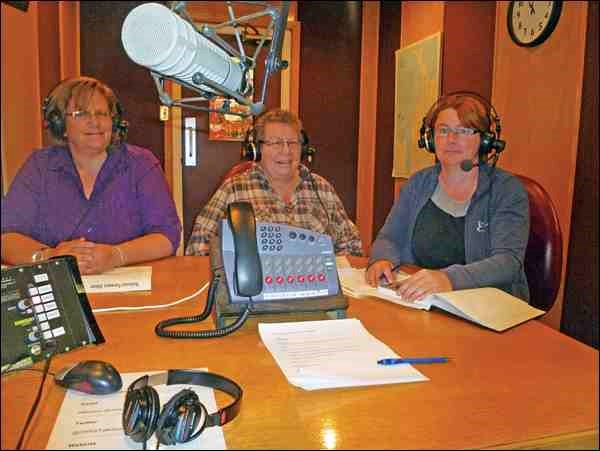After attending the Embroidery Association of Canada's annual seminar in Ottawa, Ont., in May - where I won the Members' Choice third prize for my three-dimensional magnolia/hummingbird - I extended my trip, spending a week visiting with farmers of the National Farmers Union in London, Orangeville, Kingston, Refrew and Ottawa.
These farmers not only showed different kinds of farms but organized two radio, one TV and several newspaper interviews for me in my new position as women's vice-president for the National Farmers Union.
It was interesting to see all the work different locals in Ontario were doing for their members. An interesting one and half hour documentary they are sharing with members is called Symphony of the Soil. I highly recommend this documentary to anyone who loves to eat.
One local hosted a "Bees N' Seeds" meeting to inform members of the omnibus Bill C-18, the seed Act, before Parliament as well as making a presentation to the Senate agriculture committee regarding problems with bees and neonicotinoid seed treatments.
Types of farms I visited were a beef/market garden farm, the Bruce Huron Produce Auction for the maple syrup sale, a farm eco-village, a robotic arms dairy farm, a heritage hog farm, the Morning Glory hippy farm, Madonna House/St. Benedict farm and a rabbit farm/tree nursery. Each was distinctly different.
The Orangeville farm eco-village houses 11 units under one roof and is heated geo-thermally with walls constructed of structural insulated panels.
The robotic dairy farm was using a straw bedding pack, cultivated twice a day, made up of clay and sand with straw added every day. Three local businesses work together to supply repairs for this operation as financially they couldn't handle it alone. I understood that repairs averaged $2,000 a month. As the robotic arms are working 24/7, I assume the farmer has to have shift workers.
Morning Glory Farm was established in 1969. It became a land trust in 1978. Trustees and members have changed over the years, peacefully, with agreements and decisions made by consensus at weekly meetings.
It is a 100-acre farm housing about 30 humans, ages six months to 67 years. They have a small flock of chickens, a dozen layers, three goats - one milking - and two new kids, one small riding horse and one riding donkey.
They have a 26-year old pear orchard on pyrus ussuriensis (Harbin/Siberian) rootstock, with17 bearing trees of 12 varieties. At harvest they use a small hydraulic cider press, which is very efficient, as well as a hand-operated cider press, which is easier to set up and clean up and is lots quieter. They've pressed up to 300 gallons of pear juice in a season, and have pressed other people's fruit as well - a resource for the community.
The land is rocky, hilly and prone to trees sprouting up all over. The 100 acres was a former Polish mixed farm.
They are off-grid, never having been on the electric grid, though they do have access to telephone and Wi-Fi Internet.
Their economy is mostly based on working out, with supplements from large gardens that have been worked organically from the beginning in 1969. They buy some supplies from the Ottawa Valley Food Co-operative, which they also sell to.
Their house has a very efficient Viessmann solar water heater and a 70-gallon hot water storage tank that welcomes feeds from the solar water setup and the wood stove. They have two feet of cellulose fibre in the attic which gives R85. Tight straw bale walls with triple-pane windows keep winds at bay and heat loss minor. The two kilowatt solar panels, made in Ontario, gives enough power to run the house, the custom-made freezer and fridge, whose compressors are above the units so they don't warm them, and water pump, washing machine, etc.
The rain gutters fill three 150-gallon plastic tanks that have fittings for garden hoses. They're on towers so they have pressure to move the water to a large garden, 200 feet away last summer.
Every home on the farm has a solar array of one size or another. The old original log farmhouse is the community centre, with one live-in caretaker keeping the fires going in the winter and water in the kitchen from the dug well out back.
Rob was hoping to show me their downtown Morning Glory house, where they eat lunch and supper with their son and where they have their offices and his woodworking shop. It's more the active 'farmhouse" for their family's work on and for the land.
St. Joseph's Mission Madonna House/St. Benedict Farm feeds 150 people. They have eight men working on the farm of sheep, dairy and beef cattle, horses, a garden and their own cheese house. They are not sustainable without donations.
One of the radio shows played Corb Lund's The Truck Got Stuck. I especially enjoyed this verse: "We spread genetically modified canola seed. That was genetically modified for controlling the weeds. And for big old yields and margarine oil, raised hell all over that native prairie soil. Agriculture Canada is definitely gonna be looking for us."
After the EAC Seminar, I stayed an extra day to attend Ottawa's Tulip Festival. It was a very enjoyable and challenging two-week trip.




